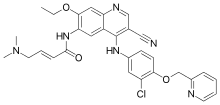Neratinib
 | |
| Clinical data | |
|---|---|
| Trade names | Nerlynx |
| Routes of administration | Oral |
| ATC code |
|
| Legal status | |
| Legal status |
|
| Identifiers | |
| |
| CAS Number | |
| PubChem CID | |
| IUPHAR/BPS | |
| ChemSpider | |
| UNII | |
| KEGG | |
| ChEMBL | |
| Chemical and physical data | |
| Formula | C30H29ClN6O3 |
| Molar mass | 557.04 g/mol |
| 3D model (JSmol) | |
| |
| |
| | |
Neratinib (INN; trade name Nerlynx; development code HKI-272)[1] is a tyrosine kinase inhibitor anticancer drug.[2]
Medical use
Neratinib is used as an adjuvant therapy in people with early stage breast cancer in which HER2 is overexpressed, after the person receives treatment with trastuzumab.[3]
People should be given drugs to prevent diarrhea when they are given neratinib.[3]
Women who are pregnant should not take it, and women should not become pregnant while taking it, and women who are breast-feeding should not use it, as it causes fetal harm.[3]
A clinical trial demonstrated that Neratinib and Temsirolimus in combination produced responses in 19% of patients ranging from 2 to 18+ months in patients with HER2-mutant lung cancers. A common toxicity, diarrhea was well-managed with loperamide prophylaxis.[4]
Adverse effects
Neratinib can cause life-threatening diarrhea in some people and mild to moderate diarrhea in almost everyone; people who take it are also at risk for complications of diarrhea like dehydration and electrolyte imbalance.[3] Similarly there is a risk of severe liver damage and many patients have some level of it; symptoms of liver damage include fatigue, nausea, vomiting, right upper quadrant pain or tenderness, fever, rash, and high levels of eosinophils.[3]
In addition to the above, more than 10% of people taking it have nausea, abdominal pain, vomiting, sores on their lips, stomach upset, decreased appetite, rashes, and muscle spasms.[3]
Interactions
People taking neratinib should not also take gastric acid reducing agents including proton pump inhibitors and H2-receptor antagonists; antacids may be used three hours before of after taking it.[3]
Drugs that inhibit CYP3A4 increase the activity of neratinib and can make adverse effects worse, and drugs that induce CYP3A4 make neratinib less active and can reduce its efficacy. Neratinib also inhibits p-glycoprotein and effectively raises the dose of drugs like digoxin that depend on it for elimination.[3]
Pharmacology
Like lapatinib and afatinib, it is a dual inhibitor of the human epidermal growth factor receptor 2 (Her2) and epidermal growth factor receptor (EGFR) kinases.[5][6] It inhibits them by covalently binding with a cysteine side chain in those proteins.[7]
Neratinib has an IC50 of 59 nM against HER2 and shows weak inhibition against KDR and Scr with IC50 values of 0.8 µM and 1.4 µM, respectively. In BT474 cells, neratinib reduces HER2 autophosphorylation, and inhibited cyclin D1 expression while reduced proliferation has been observed A431 cells when treated with neratinib at concentrations of 3 or 5 nM. In xenograft models with 3T3/neu tumors oral administration of neratinib at 10, 20, 40 or 80 mg/kg was able to inhibit tumor growth while in SK-OV-3 models doses of 5 and 60 mg/kg significantly inhibited tumor growth.[8]
Chemistry
Neratinib is a 4-anilino-3-cyano quinoline derivative. [3]
History
Neratinib was discovered and initially developed by Wyeth; Pfizer continued development up to Phase III in breast cancer, and licensed it to Puma Biotechnology in 2011.[9]
In September 2016 Puma submitted a new drug application to the US FDA for neratinib as a treatment for some people with HER-2 positive breast cancer.[10]
In July 2017 it was approved by the US FDA for adjuvant treatment of adult patients with early stage HER2-overexpressed/amplified breast cancer, (after adjuvant trastuzumab-based therapy).[11]
In January 2018 an EMA committee gave a negative review to neratinib.[12][13]
References
- ↑ "Neratinib". AdisInsight. Retrieved 22 May 2017.
- ↑ "Definition of neratinib - National Cancer Institute Drug Dictionary". Retrieved 2008-12-01.
- 1 2 3 4 5 6 7 8 9 "Neratinib tablets label" (PDF). FDA. July 2017. Retrieved 6 February 2018. For label updates see, FDA index page for NDA 208051
- ↑ Gandhi L, et al. "MA04.02 Neratinib ± Temsirolimus in HER2-mutant lung cancers: an international, randomized phase II study". Journal of Thoracic Oncology. 12 (1): S358–9. doi:10.1016/j.jtho.2016.11.398.
- ↑ Baselga, J; Coleman, RE; Cortés, J; Janni, W (November 2017). "Advances in the management of HER2-positive early breast cancer". Critical reviews in oncology/hematology. 119: 113–122. doi:10.1016/j.critrevonc.2017.10.001. PMC 5662944. PMID 29042085.
- ↑ Minami Y, Shimamura T, Shah K, et al. (July 2007). "The major lung cancer-derived mutants of ERBB2 are oncogenic and are associated with sensitivity to the irreversible EGFR/ERBB2 inhibitor HKI-272". Oncogene. 26 (34): 5023–7. doi:10.1038/sj.onc.1210292. PMID 17311002.
- ↑ Singh, J; Petter, RC; Baillie, TA; Whitty, A (April 2011). "The resurgence of covalent drugs". Nature Reviews. Drug Discovery. 10 (4): 307–17. doi:10.1038/nrd3410. PMID 21455239.
- ↑ "Neratinib, HKI-272, CAS 698387-09-6". Medchem Express. Retrieved 6 February 2018.
- ↑ "Puma Acquires Global Rights to Pfizer's Phase III Breast Cancer Drug Neratinib". GEN. October 6, 2011.
- ↑ Sagonowsky, Eric (September 27, 2016). "Cancer hopeful neratinib plagued by diarrhea, analysis shows, but Puma cites a solution". FiercePharma.
- ↑ FDA approves neratinib for extended adjuvant treatment of early stage HER2-positive breast cancer. July 2017
- ↑ Carroll, John (23 January 2018). "Puma Biotechnology shares tank after CHMP looks ready to hit a red light on neratinib". Endpoints.
- ↑ "Puma Biotechnology sinks after Europe unlikely to OK breast cancer dru". Reuters. 23 January 2018.